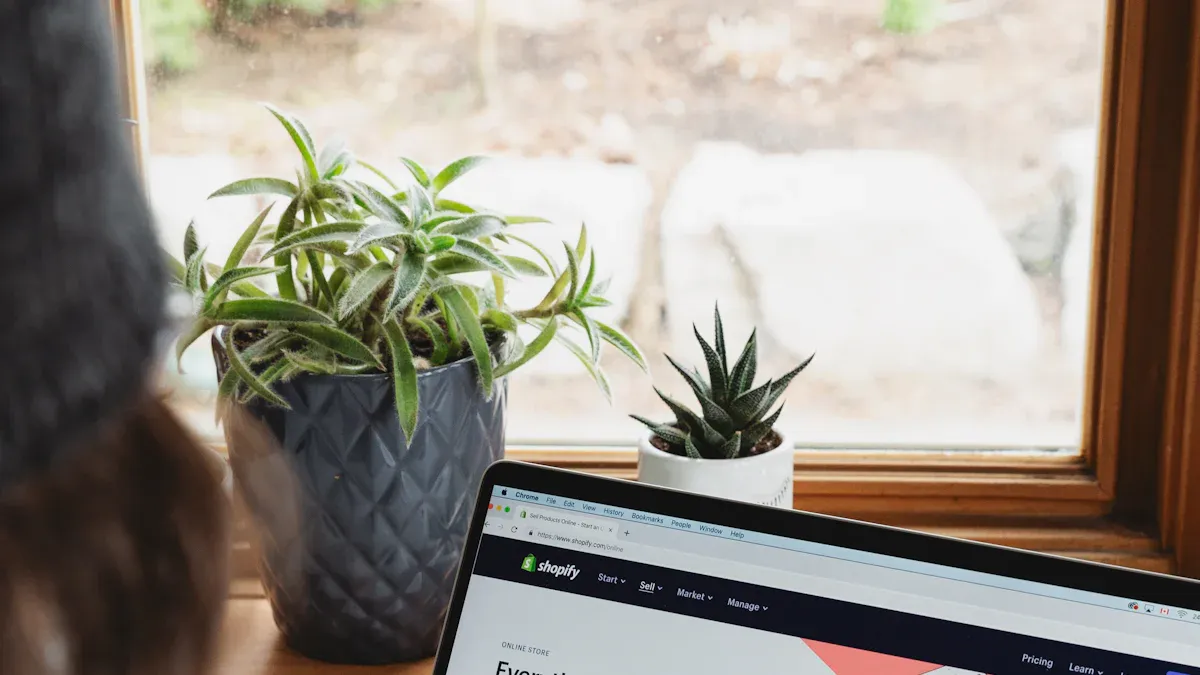The Ultimate Guide to AI Portfolio Website Builders in 2025

Creating a portfolio is now incredibly simple with an AI portfolio website builder. These tools enable you to design impressive websites without requiring any technical skills. They utilize advanced algorithms to manage layouts and enhance content, saving you both time and energy.
A growing number of individuals are adopting these tools regularly. Approximately 36% of web designers utilize AI every day, with more than half employing it to generate images and website designs. Professionals leverage AI portfolio website builders to showcase their work efficiently and effectively in today’s fast-paced online environment.
Key Takeaways
AI website builders make creating websites easy. You don’t need coding skills. They handle the hard parts so you can focus on your work.
A responsive design is very important. It makes your site look good on phones, tablets, and computers. This helps people enjoy your site and find it on search engines.
Templates you can change let you show your style. Pick designs that match your brand and make your site stand out.
SEO helps people find your site online. Use good keywords and write helpful content to rank higher on search engines.
Update your portfolio often to keep it interesting. Adding new projects and skills shows your progress and keeps visitors coming back.
What Are AI Portfolio Website Builders?
Definition and purpose of AI portfolio website builders
An AI portfolio website builder is a tool that uses smart technology to help you make a professional website easily. These tools make designing and managing portfolio websites simple by handling tricky tasks like organizing layouts, adding videos or pictures, and making sure the site works on all devices. Whether you're a freelancer showing off your projects or an artist sharing your creative work, AI tools help you display your work in a neat and attractive way.
These tools are made for everyone, even if you don’t know coding. You can focus on adding your content and personal style while the AI takes care of the technical stuff. They make sure your website looks great, works well, and is easy to find online. In 2025, these tools are super helpful for anyone who wants a strong online presence.
How AI technology transforms website creation
AI has changed how websites are built. Before, you needed to know coding and design, but now AI tools make it much easier. Instead of writing code, you can use simple commands or drag-and-drop features to create your site. This makes building websites faster and less confusing.
For example, AI tools look at what you upload—like pictures, project details, and branding ideas—and create layouts that show off your work nicely. They also make sure your site looks good on phones and tablets. Tools like Bolt and Lovable are growing fast because more people want AI-powered website builders.
Key Aspect | Description |
|---|---|
Helps both beginners and experts create websites without coding. | |
Growing Popularity | Tools like Bolt and Lovable are becoming more popular and successful. |
Easier Design Methods | Users can now design websites using simple tools instead of coding. |
Better Website Experience | AI improves how websites look and work, making them more user-friendly. |
Future of Smart Websites | Shows a trend toward smarter, faster, and more creative website designs. |
AI also adds useful features to your portfolio website. It helps with search engine rankings, supports videos and images, and tracks visitor activity. These upgrades make AI tools a must-have for professionals and creatives in 2025.
Why professionals and creatives need portfolio websites in 2025
A portfolio website is more than just showing your work; it helps you build your brand and find new opportunities. In 2025, having a strong online presence is important for standing out. A good portfolio lets you share your skills, achievements, and personality with clients and employers.
AI tools make creating a portfolio website simple and customizable. You can pick templates that match your style and make sure visitors can easily explore your site. Features like an "About" page, client reviews, and a list of services help you look trustworthy and professional. You can even add a blog to share more about your projects and ideas, keeping your audience interested.
Component | Description |
|---|---|
Online Presence | Helps professionals show their work and attract clients. |
Custom Templates | Lets users design portfolios that match their personal style. |
Easy Navigation | Makes sure visitors can explore the site without confusion. |
Shares your experience and skills to build trust. | |
Booking Page | Lets clients easily contact you for services. |
Blog | Gives more details about your work and ideas to engage visitors. |
Client Reviews | Builds trust by showing positive feedback from past clients. |
Services List | Clearly shows what you offer to help clients decide. |
Resume/CV | Displays your work history and skills for employers. |
Social Media Links | Connects your portfolio to your other online profiles. |
An AI portfolio website builder helps you create a standout portfolio in a competitive market. Whether you’re showing off your art or sharing your freelance projects, these tools make your work shine. With AI handling the technical parts, you can focus on being creative and showing your best work.
Key Features to Look for in AI Portfolio Website Builders
Responsive design for mobile and desktop users
Responsive design makes your portfolio look good on any device. It adjusts layouts and content to fit screens like phones, tablets, or computers. This means you don’t need separate sites for mobile and desktop, saving time and effort.
It also helps people with disabilities access your site easily. Search engines prefer responsive sites, which can improve your SEO and make your site more visible. Faster loading and easy navigation keep visitors happy while exploring your work.
Tip: Choose responsive design to make your site user-friendly and attract more visitors.
Customizable templates for branding and personalization
Customizable templates let you design your portfolio to match your style. You can pick from many templates made for different jobs or industries. Change colors, fonts, and layouts to create a unique look that fits your goals.
For example, a company in Belfast used AI templates to add tools like a tax calculator and secure file sharing. These changes brought them 35% more leads and 28% better mobile results.
Note: Custom templates help show your personality and meet your business needs.
Multimedia support for showcasing images, videos, and projects
Multimedia support helps you show your work in the best way. AI tools let you upload clear images, add videos, and organize projects in neat galleries. This makes your portfolio stand out and shows your skills clearly.
Use multimedia to share achievements, explain your process, or show client reviews. For instance, a video of your design process can impress clients and show your expertise.
Tip: Add multimedia to make your portfolio fun and unforgettable.
SEO optimization for better visibility online.
SEO helps your portfolio website get noticed by more people. When your site appears higher on Google, it gets more visitors. Studies show the top five Google results get 67.6% of clicks. This means good SEO can bring more traffic to your site.
Being at the top of search results also builds trust. People think top-ranked sites are reliable, which can lead to more clients. SEO also gives clear results. You can check how your site is doing and make changes to improve it. This helps you get better results for your efforts. By improving SEO, you stay ahead of others in your field.
To boost SEO, use the right keywords, write great content, and make sure your site loads fast. A well-optimized site not only brings visitors but keeps them interested.
Tip: Use tools like Google Analytics to track your site's success and improve your SEO plan.
Security features to protect your data and content.
Keeping your portfolio safe from hackers is very important. AI portfolio builders often include tools to protect your data. These tools may have SSL certificates, which keep your site secure. They also protect private details like client information or project files.
Some builders save backups automatically. This keeps your content safe even if something goes wrong. Firewalls and malware scanners are also common. They block hackers and keep your site working well.
Note: Pick a builder that focuses on security. A safe site protects your work and earns trust from visitors.
Integration capabilities with social media and analytics tools.
Connecting your portfolio to social media and analytics tools makes it better. Social media links let visitors share your work easily. They also help you reach more people. For example, adding social buttons lets users follow you or share your projects.
Analytics tools, like Google Analytics, show how visitors use your site. You can see which pages are popular and how people interact with your content. This helps you make smart changes to improve your site.
Tip: Use analytics to spot trends and adjust your portfolio to match what people like.
Step-by-Step Guide to Create Portfolio Website Using AI Tools

Picking the best AI portfolio builder (e.g., EasySite.ai)
Choosing the right AI portfolio builder is the first step. You need a tool that fits your goals and needs. For example, EasySite.ai is popular because it’s simple to use. It offers smart tools to design and automate your site. You can focus on your work while the AI handles layouts and mobile-friendly designs.
When picking an AI builder, think about these:
Ease of Use: Find tools with drag-and-drop features and simple menus.
Customization Options: Make sure you can change templates to match your style.
SEO Features: Pick a builder that helps your site rank higher online.
Multimedia Support: Check if it works well with images, videos, and animations.
Security Measures: Choose builders with SSL and backups to keep data safe.
Tip: Compare tools like EasySite.ai, Wix, and Adobe Portfolio to find the best fit for your work.
Picking and personalizing a template
Templates are the base of your portfolio website. AI builders offer many pre-made templates for different jobs. Pick one that matches your style or job type.
After choosing, make it your own. Change colors, fonts, and layouts to match your brand. Add your logo and adjust menus for easy navigation. For example, photographers might use gallery layouts to show photos. Developers might focus on project details and demo links.
Note: Personalizing templates makes your portfolio unique and eye-catching.
Adding content: projects, pictures, and details
Content is the most important part of your portfolio. Use your AI builder to upload projects, pictures, and descriptions that show your skills. Group your work into sections for easy browsing. For example, create areas for finished projects, ongoing work, and client reviews.
Here are tips for adding content:
Use Targeted Keywords: Add keywords in titles and descriptions to help people find you.
Show Results: Highlight how your work made a difference, like boosting sales.
Include Multimedia: Use clear pictures and videos to make your site interesting.
Speed Up Loading: Compress files so your site loads faster.
Make It Mobile-Friendly: Ensure your site looks good on phones and tablets.
Tip: Update your portfolio often with new work. This shows growth and keeps it fresh.
Optimizing for SEO and mobile responsiveness.
SEO and mobile responsiveness are important for making your website successful. They help your site reach the right people and work well on all devices.
Steps to Optimize for SEO
Use Relevant Keywords
Find keywords that match your job or field. For example, if you're a graphic designer, use words like "freelance graphic designer" or "creative portfolio." Add these keywords to titles, headings, and descriptions.Write Simple and Clear Content
Make content easy to understand for your audience. Explain your projects and skills in plain language. Only use technical terms if needed for your profession.Improve Images and Videos
Make images and videos smaller to load faster. Use clear file names and add alt text to help with SEO and accessibility.Add Meta Tags and Descriptions
Write short meta titles and descriptions for each page. These show up in search results and explain what your site offers.Link to Other Pages
Add links to pages on your site to help visitors navigate. Include links to trusted websites to make your site more reliable.Track Performance with Analytics
Use tools like Google Analytics to see how your site is doing. Check which pages get the most visitors and improve them.
Tip: Keep your site fresh by adding new projects or blog posts often. Search engines like active websites.
Making Your Site Mobile-Friendly
A mobile-friendly site works well on phones and tablets. This gives users a smooth experience no matter what device they use. Here’s how to do it:
Pick a Mobile-Friendly Template
Many AI builders have templates that adjust layouts for mobile devices. Choose one that works automatically.Test Your Site on Different Devices
Look at your site on phones, tablets, and computers. Use tools like Google's Mobile-Friendly Test to find problems.Keep Navigation Simple
Use menus that are easy to follow and buttons that are big enough to click. Avoid designs that feel crowded or confusing.Speed Up Your Site
Make files smaller and avoid using too many scripts. A fast site keeps visitors interested and helps your SEO.
Note: Over half of web traffic comes from mobile users. A responsive design helps you connect with more people.
Publishing and Promoting Your Portfolio
Publishing your portfolio is just the start. Promoting it helps you reach the right audience and find new opportunities.
Publishing Your Portfolio
Pick a Good Domain Name
Choose a domain name that matches your brand or job. For example, "JohnDoeDesigns.com" looks more professional than a random URL.Check for Mistakes
Look for typos, broken links, or missing pictures. A clean website makes a great first impression.Set Up Analytics Tools
Add tools like Google Analytics before launching your site. These help you track visitors and improve your site later.Launch Your Site
Use your AI builder’s hosting options to publish your portfolio. Many tools make this process quick and easy.
Tip: Share your site with friends or coworkers first. Their feedback can help you fix small issues.
Promoting Your Portfolio
Share on Social Media
Post your portfolio on LinkedIn, Instagram, or Twitter. Highlight your best projects or achievements in your posts.Join Online Groups
Take part in forums or communities related to your field. Share your portfolio when it fits the conversation, but don’t spam.Send Emails
Write personalized emails to potential clients or employers. Include a link to your portfolio and a short introduction.Work with Others
Team up with other professionals to promote your work. For example, a photographer could partner with a graphic designer for a project.Use Paid Ads
Try Google Ads or Facebook Ads to reach specific audiences. Even a small budget can help more people see your portfolio.Add Your Portfolio to Emails
Put a link to your portfolio in your email signature. This way, every email you send promotes your work.
Note: Keep updating and sharing your portfolio regularly. This helps you stay connected with your audience.
By improving SEO and making your site mobile-friendly, you can attract more visitors. Promoting your portfolio ensures it gets noticed and creates new opportunities.
Comparison of Top AI Portfolio Website Builders

EasySite.ai: Features, pros, and cons
EasySite.ai is simple and highly automated. It uses smart AI to design layouts based on your content. Just upload your projects, and it arranges them neatly. Its drag-and-drop tool makes editing easy for anyone. The platform also has tools to help your site rank higher on search engines.
Pros:
Easy to use, even for beginners.
Great SEO tools to boost visibility.
Automatically adjusts for mobile devices.
Cons:
Fewer templates compared to other platforms.
Premium features may cost extra.
Tip: EasySite.ai is perfect if you want a fast and simple way to build your portfolio.
Canva: Features, pros, and cons
Canva is great for creative designs. It started as a graphic design tool but now includes website-building features. You can pick from many templates and customize them easily. Canva also lets you add videos, pictures, and animations to make your site stand out.
Pros:
Huge selection of templates and design tools.
Easy-to-use editor for creative users.
Affordable for basic features.
Cons:
Fewer SEO tools than other builders.
Limited advanced analytics and integrations.
Note: Canva is ideal for creatives who care more about design than technical features.
Wix: Features, pros, and cons
Wix combines flexibility with automation. Its AI tool, "Wix ADI," creates a site based on your answers to simple questions. You can then adjust the design using its powerful editor. Wix also offers advanced analytics and connects with other tools.
Pros:
Highly customizable with many templates.
Great for connecting with social media and analytics tools.
Includes features for online stores and blogs.
Cons:
Beginners might find it overwhelming due to many options.
Advanced features need higher-priced plans.
Feature | EasySite.ai | Canva | Wix |
|---|---|---|---|
Ease of Use | ⭐⭐⭐⭐⭐ | ⭐⭐⭐⭐ | ⭐⭐⭐⭐ |
Template Variety | ⭐⭐⭐ | ⭐⭐⭐⭐⭐ | ⭐⭐⭐⭐⭐ |
SEO Tools | ⭐⭐⭐⭐ | ⭐⭐⭐ | ⭐⭐⭐⭐ |
Integration Options | ⭐⭐⭐ | ⭐⭐ | ⭐⭐⭐⭐⭐ |
Cost-Effectiveness | ⭐⭐⭐⭐ | ⭐⭐⭐⭐ | ⭐⭐⭐ |
Tip: Wix is a great choice if you want advanced features and don’t mind spending extra time customizing your site.
Adobe Portfolio: Features, pros, and cons.
Adobe Portfolio helps you make beautiful portfolio websites easily. It is part of Adobe's Creative Cloud, which is great for designers, photographers, and artists who already use Adobe tools. You can connect your work from Adobe Lightroom or Behance for a smooth experience.
Features:
Ready-made templates designed for creative professionals.
Works with Adobe tools like Lightroom and Photoshop.
Offers unlimited hosting and custom domain options.
Lets you create password-protected pages for private projects.
Pros:
Great for showing high-quality images and designs.
Saves time by linking with other Adobe tools.
Clean layouts that make your work stand out.
Cons:
Fewer options to customize compared to other platforms.
Needs an Adobe Creative Cloud subscription.
Not the best for non-creatives or advanced features like online stores.
Tip: If you already use Adobe Creative Cloud, this tool makes it easy to build a professional portfolio.
Renderforest: Features, pros, and cons.
Renderforest is a flexible platform that helps with websites and branding. You can create portfolio websites, logos, videos, and mockups all in one place. This makes it a good choice for freelancers and small businesses.
Features:
Drag-and-drop builder with smart design suggestions.
Tools to make logos, videos, and brand mockups.
Supports images, videos, and animations.
Affordable plans for beginners and small businesses.
Pros:
Combines branding and website creation in one platform.
Easy to use with AI help.
Budget-friendly for those starting out.
Cons:
Limited advanced customization options.
Templates are not as polished as specialized builders.
Not ideal for large or complex websites.
Note: Renderforest is perfect if you want a simple and affordable way to create both a portfolio and branding materials.
Key differences and which tool is best for specific needs.
The choice between Adobe Portfolio and Renderforest depends on what you need. Adobe Portfolio is best for creatives who want to show off high-quality visuals. It works well with Adobe tools, making it ideal for photographers, designers, and artists. However, it has fewer customization options and requires an Adobe subscription.
Renderforest is more versatile. It combines website building with branding tools, which is great for freelancers or small businesses. While its templates are simpler, it’s affordable and easy to use, making it a good choice for beginners.
Feature/Need | Adobe Portfolio | Renderforest |
|---|---|---|
Best For | Creatives using Adobe tools | Freelancers and small businesses |
Customization | Limited | Moderate |
Branding Tools | No | Yes |
Cost | Requires Adobe subscription | Budget-friendly |
Recommendation: Pick Adobe Portfolio if you want high-quality visuals and already use Adobe tools. Choose Renderforest if you need an affordable, all-in-one solution for branding and websites.
Tips for Improving and Personalizing Your AI-Powered Portfolio
How to make your portfolio look amazing
To make your portfolio stand out, focus on eye-catching designs. AI tools can create many layout ideas based on your style. This helps you try different looks quickly. Tools like Midjourney and DALL-E can turn text into unique pictures or videos. These add a personal touch to your site. AI also checks your design choices and gives tips to make them better.
Strategy Type | Description |
|---|---|
AI creates many layout ideas based on your preferences. | |
Image and video creation | Tools like Midjourney and DALL-E make visuals from text, speeding up creativity. |
Design improvement | AI suggests ways to make your design look better and work well. |
User experience (UX) design | AI uses visitor data to improve how people interact with your site. |
Using these ideas, you can build a portfolio that looks great and shows your unique style.
Best ways to show your work clearly
When showing your work, keep it neat and easy to explore. Group similar projects together so visitors can find them quickly. Use clear pictures and videos to highlight your skills. For example, making your design process simple can boost engagement by 20%. Easy onboarding can also make users 30% happier.
Design Change Description | Engagement Metric | Outcome |
|---|---|---|
Simplified process | Higher engagement rates | 20% more activity during busy times |
Streamlined onboarding | Better user satisfaction | 30% more completions and happier users |
Add short descriptions to explain your projects. Make sure your portfolio works well on phones since many people browse on mobile devices.
Tracking how visitors use your portfolio
Analytics tools help you see how people interact with your site. Metrics like time spent on your site and pages viewed show how interesting your content is. For example, longer visits mean people enjoy your work. Checking bounce rates and exit rates shows where visitors lose interest, so you can fix those areas.
Metric | Description |
|---|---|
Returning Visitors | Shows how well your site keeps visitors coming back. |
Session Duration | Tracks how long users stay on your site; longer times mean more interest. |
Pages Per Session | Counts how many pages visitors view; more pages mean deeper interest. |
Scroll Depth | Measures how far users scroll, showing how much content they see. |
Use these numbers to improve your portfolio and connect with your audience. Update your site often to keep it fresh and exciting.
Keep your portfolio updated to stay current and interesting.
Updating your portfolio shows your latest work and skills. It proves you are active and growing in your field. Visitors can see your newest projects, which helps them understand what you can do now. If your portfolio looks old, people might think you’re no longer working or improving.
Check your portfolio every few months to keep it fresh. Add new projects, fix descriptions, and remove old content. For example, if you finished a big project, include it with clear pictures and a short explanation of its success. This makes your portfolio exciting and up-to-date.
Use analytics tools to guide your updates. Look at which pages or projects get the most views. If some parts don’t do well, think about changing or replacing them. Checking analytics every three months helps you know what visitors like most.
Feedback is also important. Ask clients or coworkers to review your portfolio. They can give advice to make it better and more trustworthy. For instance, a client might suggest adding reviews or improving your project details.
Here’s a simple checklist to help you:
Task | What to Do |
|---|---|
Add new work and achievements to stay current. | |
Analytics Review | Check data every three months to improve popular and weak areas. |
Get Feedback | Ask others for advice to make your portfolio stronger and more reliable. |
By keeping your portfolio updated, you show you’re professional and flexible. Regular changes help you stand out and stay important in a busy market.
AI portfolio website builders have changed how you make portfolios. They save time by creating websites fast and without coding. You can use ready-made templates and simple drag-and-drop tools. These features make it easy to design and customize your site. With user-friendly setups, you can quickly create a professional-looking portfolio.
Using tools like EasySite.ai helps you show your work easily. An AI-powered portfolio keeps you ahead in today’s digital world. These tools boost your efficiency and make your portfolio stand out from others.
Tip: Start your portfolio now to find new chances and stay ahead in your career.
FAQ
What is an AI portfolio website builder?
An AI portfolio website builder is a tool that helps you make a professional website fast. It uses artificial intelligence to arrange layouts, organize content, and make your site work on phones. You don’t need to know coding to use it.
Can I use AI tools if I don’t know design?
Yes, AI tools are great for beginners. They come with ready-made templates and easy drag-and-drop options. You can change colors, fonts, and layouts without needing design skills. AI also gives tips to make your site look better.
How do AI tools help with SEO?
AI tools improve your site by suggesting keywords, speeding up loading times, and making designs mobile-friendly. They also help you write short titles and descriptions. These features make your portfolio easier to find on search engines like Google.
Are AI portfolio builders safe?
Most AI portfolio builders have safety features like SSL certificates and automatic backups. These keep your data safe and protect your site from hackers. Always pick a builder with strong security tools.
Can I change my portfolio after it’s published?
Yes, you can update your portfolio anytime. AI tools let you add new projects, edit text, or adjust designs easily. Updating often keeps your portfolio fresh and shows visitors your latest work.
Tip: Review your portfolio every few months to keep it current and interesting.
See Also
Explore 10 Innovative AI Website Builders for 2025
Discover 5 Essential AI Tools for Website Creation 2025
Best Free AI Website Builders for Developers in 2025

